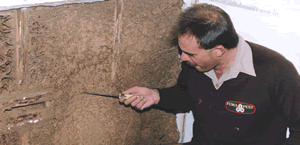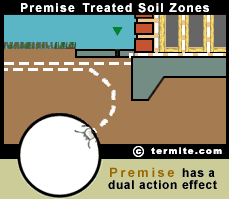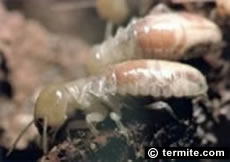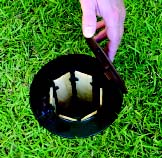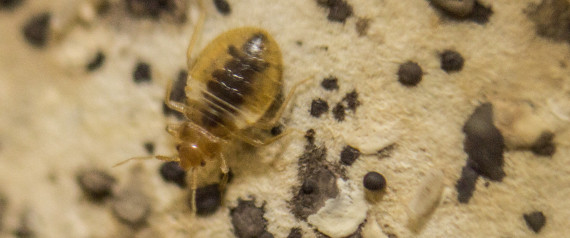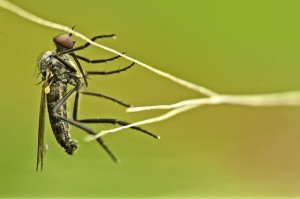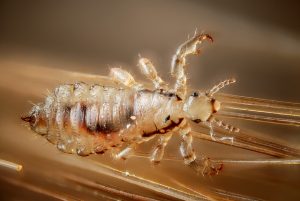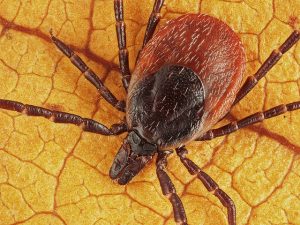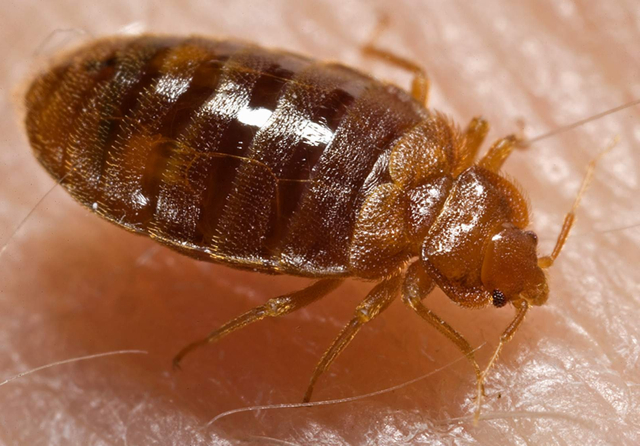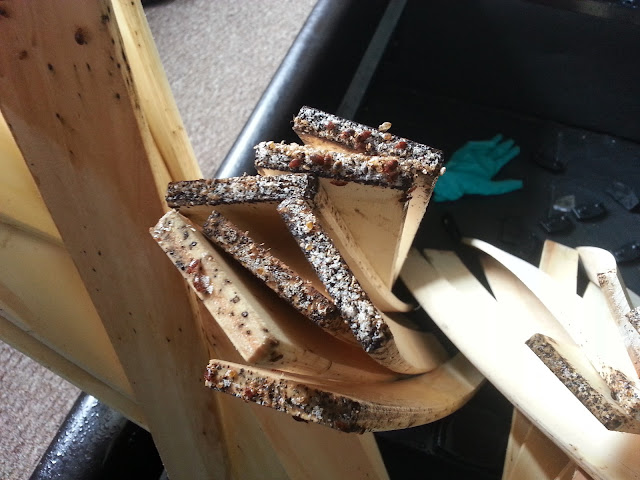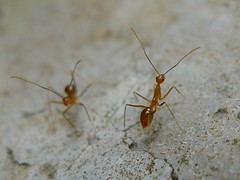Climate change is a challenging issue th…
Professional Termite Control Methods
|
INITIAL INSPECTION & REPORT requires a complete thorough inspection of the buildings and surrounds, and a detailed written report on areas inspected, evidence found of termite activity, high risk termite entry areas inaccessible to inspection and termite control options and limitations thereto. Recommended as essential.
|
|
CHEMICAL SOIL TREATMENT around the perimeter and sub-floor of a building to eradicate termites attempting to gain entry into the building through a treated soil area. On the grounds of safety and effectiveness Termidor or Premise termiticide, are recommended for this purpose - discussed in detail later in this website.
|
|
TERMITE BAITING and potential TERMITE COLONY ELIMINATION involves the installation and monitoring of termite bait stations, such as system. This method relies heavily on the termites "finding" and consuming sufficient bait. Recommended in some circumstances.
|
|
BUILDING MODIFICATIONS and MAINTENANCE including some termite risk reduction measures the homeowner carry out, such as, improving sub-floor ventilation, removal of timber in contact with the soil, opening and clearing important inspection access areas.
|
| Regular FOLLOW-UP INSPECTIONS are essential and should be carried out at least every 3 to 6 months where signs of termite activity has been located in the vicinity of susceptible buildings or timber structures. |
| Initial Inspection of Buildings & Surrounds |
|
FIRSTLY, it is essential for the termite controller to complete a thorough inspection of the buildings and surrounds. The property owner should be supplied with a written inspection report and detailed specifications for an integrated termite control program. It is essential that the inspection and report be received before any protective measures are commenced.
A professional termite inspection and report, including a termite control protection advice costs vary depending on the size of the house and the style of construction and ease of inspection access. |
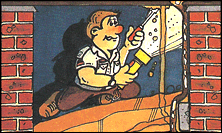 |
A professional termite inspection and report could save you thousands of dollars.
Specific areas inspected should include accessible timbers within the crawl space in the sub-floor, roof void, interior, exterior, garden landscaping, fences, other timber structures and trees in the locality. |
| Chemical Soil Treatments |
|
CONSUMER NOTE: Most home-owners are unaware that their general home insurance policy does NOT cover termite damage to structural timbers. However, appropriate professional indemnity insurance is available to professional pest controllers to cover termite damage to structural timbers in a building caused by subterranean termites gaining entry into the building through an abutting chemical soil treated area.
If there are termites in the building, at the time of chemical soil treatment, they cannot safely return to their central colony nest through the chemically treated soil. Termites are compelled to return every few days to their central colony nest in the ground to obtain moisture essential for their survival and to feed and groom the nymphs (young termites), the king, queen and other termites. The installation of a chemical soil barrier requires expert knowledge and specialized equipment to form a complete and continuous barrier to protect the building from a termite entry and infestation - as illustrated below: |
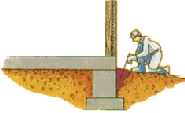 |  | 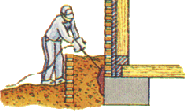 |
| Trench and treat soil around external concrete slab edge - a common termite entry point | Trench and treat soil around walls and piers in the sub-floor area | Use rod injection to treat soil along and around the external perimeter area of the building |
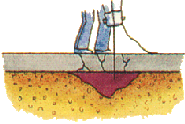 | 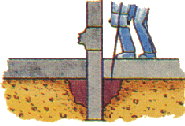 | 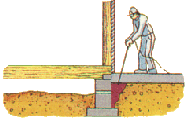 |
| Drill concrete floor along all expansion joints and cracks, and treat soil thereunder | Drill concrete floor around pipes and treat soil thereunder | Drill concrete patio areas and treat soil area therein - a high risk termite nest location |
Subterranean termites may build such a nest in a roof or wall cavity where moisture is regularly supplied, say from a leaking shower recess, broken roof tiles, faulty guttering or plumbing. |
| PESTICIDE SAFETY ISSUES - Soil Treatment Termiticides |
| There are several types of termite control chemicals registered by the relevant State and/or Federal Government Authority for use in termite control as a soil treatment chemical. |
WARNING: Several outdated products are solvent based termite control pesticides which may cause health problems to asthmatics during the drying process.
|
Termidor and Premise do NOT have an obnoxious odor or emit airborne residues or fumes. Both are registered as a low hazard insecticide with a CAUTION notation on the registered label.
|
Some alternative termiticides have a strong repellency action to deter foraging termites. Whereas Termidor and Premise are non-repellant to the termites. Termites can enter the treated soil zone without detecting the Termidor or Premise chemical. The repellant nature of other products mean the termites can detect the chemical and will move along the treated soil areas, actively seeking a gap to gain entry into the building.
Premise will act to kill termites, in the higher concentration treated soil areas abutting the building. With Premise, termites that forage in the lower concentrated treated soil areas, will become disorientated, stop feeding, and are fatally diseased by natural fungi and micro-organisms in the soil. |
|
Both Bayer Premise and BASF Termidor claim their products will transfer from one affected termite to another ... the technology aimed at eradicating the queen termite and the entire colony - refer to the animated illustration below:
|
 Termites tunneling in the Premise treated soil area abutting the building (of high concentration - near the point of application) are killed outright. Termites tunneling in the Premise treated soil area abutting the building (of high concentration - near the point of application) are killed outright.
 Termites tunneling in the outer parts of a Premise treated soil area (of low concentration) will not detect the Premise which adheres to their bodies and has a delayed lethal effect of several days - enough time to be transferred back to the central colony nest. Termites tunneling in the outer parts of a Premise treated soil area (of low concentration) will not detect the Premise which adheres to their bodies and has a delayed lethal effect of several days - enough time to be transferred back to the central colony nest.
After 250 million years of living underground, subterranean termites have evolved with a very thin waxy skin (called an exoskeleton) that readily absorbs moisture. The Premise active adheres to the termite exoskeleton and is readily adsorbed through the exoskeleton and into the termite's body to immobilize and kill the affected termite within a few days. The termites spread the Premise to other termites during regular physical contact, particularly when working together in close proximity, grooming and feeding the rest of the colony, a regular function of their daily life. Termites carry away or cannibalize other dead termites, further spreading the deadly effect of the Premise chemical throughout the colony. |
| Termite Baits & Termite Baiting Systems |
|
The Sentricon termite monitoring and baiting system was developed by Dow AgroSciences, USA. The Sentricon bait is an insect growth regulator, which is designed to be spread throughout the colony by the worker termites.
An insect growth regulator affects termites by stopping the molting process required for the termites to grow. As the worker termites die off, the termite colony declines to the point where it can no longer sustain itself, ultimately leading to it's collapse and elimination. The Exterra termite monitoring and baiting system is owned by Ensystex, USA. The Exterra termite bait is also an insect growth regulator. Both Sentricon and Exterra systems have their own plastic bait stations which must be used with their product. These bait stations can be placed in the ground and checked regularly. Termite colony elimination in favorable circumstances may take several weeks to a few months. However, in some cases, termite colony elimination is unsuccessful or may take years, depending on the circumstances. Where a large number of termites find and consume the bait, then colony elimination is virtually assured within a few months. This is where the experience and skill of the termite controller is paramount to decide if and where a baiting program is implemented and properly monitored. Both the Sentricon and Exterra termite baits are designed to be slow acting, non-repellant and therefore spread to other termites in the colony before the colony can detect where the deadly effect is coming from. Termites have acute survival instincts. The location of a toxic food source if detected, will be abandoned. Too much disturbance of the foraging termites (workers and soldiers) in a particular location, will alert the termite colony to abandon the area. The termites appear to be gone, but may in fact be entering the building in other areas. Your home is a much bigger bait station. Both the Exterra and Sentricon termite baiting systems are subject to regular inspection and monitoring by the termite controller. The larger the number of termites that consume the bait, the quicker and more certain is the termite colony elimination process. It is usual to re-inspect the bait stations and the buildings and surrounds every month to reposition, reapply or replenish the bait, if necessary. This process is labor intensive so that the long term cost of the monitoring / baiting system may accumulate out of hand before the chance of success or otherwise, is realized. |
 |
Ring the Experts: successful termite protection of a building using a baiting program often requires expert skill and judgment, based upon years of field-work experience in termite control in a wide variety of circumstances.
One critical aspect is the bait stations should to installed in areas where termites are more likely to be foraging. The termites must "find" the stations to have any chance of success. |
The Sentricon baits are placed in their in-ground bait stations after removal of the termite infested timber therein. This may involve sufficient disruption of the termites such that they avoid the in-ground Sentricon bait station, entirely. This serious short-coming is overcome by the patented Exterra Termite Stations where the timber is aligned around the cylinder such that the bait can be inserted without such disturbance of the termites present. RECOMMENDATION: Exterra or Sentricon be used where a complete chemical soil barrier treatment using Termidor or Premise is not practicable or desired, and where a several thousand termites are likely to eat the bait. A termite monitoring and baiting program can be integrated with a range of methods including (1) drilling susceptible trees and eradication of any termite nest located therein, and (2) in conjunction with a follow up chemical soil treatment using Termidor or Premise. |
| Building Modifications & Maintenance |
|
Rapid termite colony development and building infestation is usually associated with a readily available timber food and moisture source nearby the central nest. In addition, buildings are often constructed in a way that allow termites to gain undetectable entry from the soil to the structural timbers of the building. Listed below are some useful recommendations for the home owner to carry out in order to reduce the risk of termite activity inside a building.
Moisture exclusion from inside the wall cavities, around the base of the building and sub-floor area (if any). Water run-off can be excluded from a sub-floor area by the installation of ag-drains. Make sure there is adequate cross flow ventilation in the sub-floor area. In addition, a qualified plumber should be engaged to ensure there is no water leakage from plumbing pipes in the bathroom, the shower recess, kitchen, down pipes, guttering and air conditioning unit overflow. Look for signs of dampness in the wall cavities, broken roof tiles, faulty guttering and the like. Please note: high humidity, dampness or moisture accumulating in a wall cavity is of high risk to encouraging large scale termite activity inside the building. Removal of any timber in contact with the soil. Timbers should be stored above ground to allow full inspection of subterranean termite activity (coming from the soil thereunder). Any landscaping using timber chip mulch and railway sleepers should definitely be removed, as they provide ready food source to assist in rapid termite colony development. Ensure inspection access is unimpeded, particularly in sub-floor areas (suspended floors) in order to look for evidence of termite activity. If your property is on a concrete slab on ground flooring, make sure you can inspect the entire external slab edge for evidence of termite mud-shelter tubes. Do NOT allow this area to be covered by pavers, landscaping, planter pots, etc, as termites often gain entry into the walls of a building via this locality, particularly through external weep holes and minute gaps in the mortar in brick-work. If you find live termites or termite damaged timbers DO NOT disturb the area. DO NOT use spray can or insecticides on the termites. If sufficiently disturbed, the termites are likely to move elsewhere, and may not be rediscovered until further obvious damage has been done. The termite controller can introduce Intrigue termite dust or Exterra termite bait directly to the live termites present in an attempt to eliminate the entire termite colony - as discussed in detail above. |
| Regular Follow-up Inspections & Monitoring |
We usually recommend 3 or 6 monthly inspections be carried for the first 24 months following a chemical soil treatment. Monitoring of "stand-alone" baiting systems should be carried out every 4 to 6 weeks. |
| A Word of Warning: the correct identification of a destructive termite species, inspection of a building for tell-tale signs, analysis of your circumstances and the design and implementation of an effective program for the protection of a building from termite infestations, requires expert skill and judgment based upon professional training and extensive field-work experience in termite control in a wide variety of circumstances. |
| Do NOT attempt do-it-yourself termite control ...leave it to the experts |
Review us on BusinessList.co.ke
Termite Control Services
Show us the area(s) of concern and we will perform a free limited inspection that is usually non-invasive.
Many times these areas require only small local, low cost treatments.
Letting these existing problems compound over time does not make good sense.
Drywood Termites
With Alpha's Termite Radar, we can now detect all infestations inside your walls. You no longer have to tent to eliminate termites.
We Guarantee It!
Subterranean Termites
Your second most important asset you have!!
Your home...
...of course, your family is first.
Here at Alpha Ecological Pest Control we pride ourselves in giving our customers a professional and friendly service together with advice based on what is right for you. Each home owner has different needs and requires an idividual approach to their pest management. One thing they all have in common though is the need to have regular termite inspections.
The building code highly recommends 6 monthly and no longer than 12 monthly inspections of properties. Here in Alice Springs we highly recommend 6 monthly inspections for high risk properties. How do i know if my home is high risk you ask?
There are some things that you can assess yourself to see if you fall into this category. These are; do you live in Alice Springs and...
1. Is your home built on a slab?
2. Are the walls built with a timber frame?
3. Is your roof truss made from timber?
4. Does any timber contact the ground and attach to the house?
5. Has it been more than 12 months since your last inspection?
6. Does your property have large trees or are there any nearby?
7. Has there been any previous termite treatment done?
8. Are there any garden beds adjacent to the home?
9. Is there any prolonged moisture (leaks etc) around the home?
10. Are you aware of any neighbours that have a problem?
If you answered yes to two or more of these questions then unfortunately you fall into the high risk category, don’t panic.
Alpha termite control services Kenya provides premier termite control in Nairobi and all-over Kenya for both home-owners and businesses to protect their properties.
Termites are of great value in nature as they help break down cellulose and create rich soil. Fallen trees and old logs are broken down into nutritious soil enrichments. But when termites get near or into our structures, they must be controlled. Termite extermination, annual cost of termite damage to buildings in KENYA is greater than that of fires, storms and floods combined according to researchers.
Termites is the common name of a group of chemically complex insects that live in communities as ants do. They have long been known as white ants however this is not entirely accurate for termites are like ants only in their habits of living together and that they are small in size. Actually termites are more closely related to cockroaches and grasshoppers.
Termites digest wood, paper , and other material containing cellulose, with aid of protozoain their bodies. They do much damage in tunnelling through the wood work of houses destroy books and furniture , and do great damage by tunnelling through fence posts, trees, timbers of wooden buildings, bridges ,trestles , and other structures. In houses they eat, cloth furniture, books and paper.
Fleas & Flea Control in Nairobi
The Right way to Keep Pest Outside
 |
Pest Control Services in Nairobi
Keep Pests Out of Apartments - Alpha Ecological Pest Control
For those who live in apartments, pest c…
Control Cockroaches In Residentials and offices
Most people are very intolerant of cockr…
Homeowners and Tenant
When your home is infested with bed bugs…
Bed bugs Control in Nairobi,Kenya
They Crawl, They Bite, They Baffle Scien…
Buying used furniture? Here’s how to check used furniture for bed bug
 In today’s economy, everyone wants to sa…
In today’s economy, everyone wants to sa…
Termites
Conehead Termites
Conehead …Health Checks - Rodent Infestations
Rodent infestations in the home can have…
How to Pest-Proof Your Attic & Basement
Many people are anxious about encounteri…
What You Don't Know About Squirrels
You know those furry little creatures th…
Bed Bugs Playing Hide-and-Seek in Used Items
Five Little-Known Facts about Dragonflies
The Crazy Rasberry Ant: What Is It and How Can You Control It?
The Top Five Nutritious Foods to Feed Your Lizard
Why are schools are such a hot spot for bed bugs
The reason schools are such a hot spot f…
